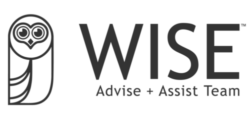3 Types of SEO Entrepreneurs Need to Master
As an entrepreneur or small business owner, you have probably heard of SEO – search engine optimization – and how it’s essential for your business. Did you know that there is more to SEO than keywords? Here at WISE, we have identified the three major subtypes of SEO and how they impact your overall digital marketing strategy.

search results on search engines.” –Search Engine Land
Content SEO
The most well-known aspect of SEO is keywords. This is because they are an essential part of your Content SEO: without relevant keywords, how will search engines know your content answers the question that their searcher has asked? Content SEO is focused on ensuring your content appears to searchers who will find it relevant and informative.
The three most essential aspects of Content SEO are keyword research, content consistency, and content optimization.
- Keyword research involves identifying the reasons why people are searching for keywords related to your business.
- Content consistency involves developing a content plan for your site that is interesting, relevant, and consistently added to your site.
- Content optimization requires using the keywords from your keyword research and the schedule you created for content consistency to develop content relevant to your business and your target audience.
Technical SEO
While Content SEO is focused on your content development and target audience, Technical SEO is focused on the backend optimization that must occur for each content piece. It is about ensuring your content is read by search engines in the manner you anticipate, and that content is easily digestible by your human readers.
The most essential aspects of Technical SEO implementation are:
- Optimizing your content titles and headlines to contain keywords.
- Optimizing your meta descriptions to include a brief description of your content that will appear on the search engine result page alongside the title.
- Structuring your website code to create a native schema markup.
Architecture SEO
Content SEO and Technical SEO are all about the content. Architecture SEO, on the other hand, is all about your website, its functionality, and its structure. The same way you can use an index or table of contents to complete research in a book, your website’s organization and sitemap tells search engines the best way to “read” your site.
When setting up, or updating, your website’s architecture, you need to keep in mind:
- Crawlability – make sure you have an xml sitemap and submit it to the major search engines.
- URLs – make sure that your URLs are descriptive and relevant to your content.
- Mobile Friendliness – search engines are less likely to show your content to searchers if your site isn’t optimized for a mobile browsing experience.
- Duplicate Content – having high-quality and consistent content is important, but duplicate content and copy actually hurt your search engine ranking.
We know you’re busy, and that’s why WISE is here to help every step of the way. If you feel too overwhelmed, or don’t know where to start, let our team put together a comprehensive SEO Audit for you — we’d love to help you implement the suggestions as well! Schedule a call with our team today to learn more.
